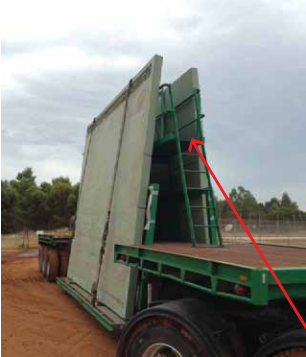The transport of precast panels/elements exposes workers to the risk of falls from height during the loading and unloading process, in particular:
- riggers/dogmen, as they rig and release panels/elements
- transport workers/drivers, as they secure and release panels/elements
- those involved in preparing panels/elements for hoisting eg cleaning ferrules and lifting points.
The transport of precast panels/elements requires a safe and efficient means of accessing the panels/elements to secure and release the load before and after it is moved. As this is considered a high risk construction work activity, a detailed, task-specific Safe Work Method Statement must be developed.
To minimise the risk of injury to workers, PCBUs have a shared responsibility with principal contractors to provide, so far as is reasonably practicable:
- a safe working environment
- safe systems of work
- plant and substances in a safe condition.
PCBUs involved in the transporting of precast panels/ elements may also have additional, more specific duties if they:
- are a principal contractor
- have management or control of a workplace
- have management or control of fixtures, fittings or plant at workplaces
- are involved in the design of plant, substances or structures
- are involved in the manufacture of plant, substances or structures
- import plant, substances or structures
- supply plant, substances or structures
- install, construct or commission plant or structures.
PCBUs involved in the design, manufacture, rigging, loading or transport of precast panels/elements also have a legislated responsibility to, so far as is reasonably practicable, consult, co-operate and co-ordinate with other duty holders.
Risk control measures
Where possible, you must eliminate the risk of falls from height when transporting precast panels/elements. Workers must be provided with protection against potential injury.

Controls to prevent falls from height include:
- working from the ground
- working from a solid construction (platform)
- use of temporary work platforms (elevated work platform, scaffold)
- use of ladders that have engineered fall protection eg hoop ladders, platform ladders
- working from ladders is a high risk activity and should only be used if there is no other reasonably practicable alternative
- assessing ground conditions prior to loading and unloading.
Engineered controls such as handrails provide the best protection against falls from height.
Where reasonably practicable, engineered fall protection and access should be provided.
Support frames
Support frames used for the transport of precast panels/elements must:
- be capable of supporting all loading conditions, including shock and vibrations arising from the transport
- be designed and engineered by a competent person
- have engineered controls (eg handrails, solid platform, fixed ladder) to enable safe access onto and egress from the vehicle while loading and unloading
- be regularly inspected.
Engineering details, specifications and inspection reports must be available upon request.
Rigging licences
Workers involved in the rigging of precast panels/elements during the loading and unloading process must hold a relevant licence to perform high risk work in one or more of the following:
- crane operation (various licence classes, depending upon crane type and capacity)
- dogging (DG), noting that this does not allow for installation of precast panels/elements
- rigging (RB, RI, RA).
Further information
Work Health and Safety Act 2012 (SA)
Work Health and Safety Regulations 2012 (SA)
Managing the risk of falls in the workplace – Code of Practice
Construction work – Code of Practice
AS 2550.1: Cranes, hoists and winches – Safe use – General requirements - available from our Library
Load Restraint Guide (second edition 2004) – National Transport Commission


